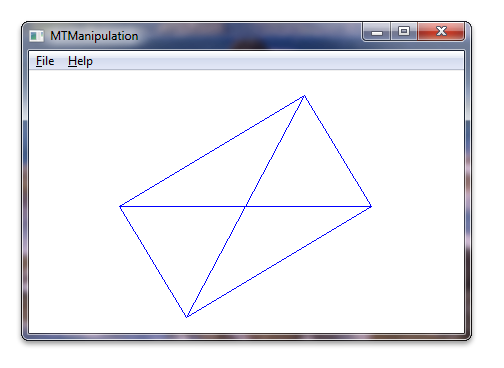Windows 터치 조작 샘플(MTManipulation)
이 섹션에서는 Windows 터치 조작 샘플에 대해 설명합니다.
Windows 터치 조작 샘플에서는 IManipulationProcessor 인터페이스를 사용하여 개체를 변환, 회전 및 크기 조정하고 _IManipulationEvents 이벤트 싱크를 구현하는 방법을 보여 줍니다. 다음 스크린샷은 샘플이 실행 중일 때 어떻게 보이는지 보여줍니다.

이 샘플의 경우 프로그래밍 방식으로 변환, 회전 또는 스케일링할 수 있는 CDrawingObject 클래스가 만들어집니다. IManipulationProcessor 인터페이스가 인스턴스화됩니다. 생성자의 CDrawingObject 클래스 및 IManipulationProcessor 인터페이스에 대한 포인터를 허용하는 조작 이벤트 싱크가 만들어집니다. IManipulationProcessor에 대한 연결점은 IManipulationProcessor 에서 발생한 이벤트를 이벤트 싱크에서 수신하도록 조작 이벤트 싱크 구현에서 만들어집니다. 터치 데이터는 IManipulationProcessor 인터페이스에 공급되고 인터페이스는 _IManipulationEvent 이벤트를 발생합니다. CManipulationEventSink 클래스의 이벤트 처리기는 CDrawingObject에 대한 포인터에서 접근자를 호출하여 CDrawingObject의 방향을 업데이트합니다.
다음 코드에서는 터치를 위해 창을 설정하는 방법과 CDrawingObject 및 IManipulationProcessor 가 인스턴스화되고 CManipulationEventSink 생성자에 전달되는 방법을 보여 줍니다.
CDrawingObject g_cRect; // CDrawingObject class holds information about the rectangle
// and it is responsible for painting the rectangle.
(...)
BOOL InitInstance(HINSTANCE hInstance, int nCmdShow)
{
(...)
// Register application window for receiving multi-touch input. Use default settings.
if (!RegisterTouchWindow(hWnd, 0))
{
MessageBox(hWnd, L"Cannot register application window for multi-touch input", L"Error", MB_OK);
return FALSE;
}
ASSERT(IsTouchWindow(hWnd, NULL));
// Instantiate the ManipulationProcessor object
HRESULT hr = CoCreateInstance(__uuidof(ManipulationProcessor), NULL, CLSCTX_ALL, IID_PPV_ARGS(&g_pIManipProc));
if (FAILED(hr))
{
ASSERT(SUCCEEDED(hr) && L"InitInstance: failed to instantiate the ManipulationProcessor object");
return FALSE;
}
// Instantiate the event sink with the manipulation processor and pointer to the rectangle object
g_pManipulationEventSink = new CManipulationEventSink(&g_cRect);
if (g_pManipulationEventSink == NULL)
{
ASSERT(g_pManipulationEventSink && L"InitInstance: failed to instantiate the CManipulationEventSink class");
g_pIManipProc->Release();
g_pIManipProc = NULL;
return FALSE;
}
// Establish the link between ManipulationEventSink and ManipulationProcessor
if (!g_pManipulationEventSink->Connect(g_pIManipProc))
{
ASSERT(FALSE && L"InitInstance: failed to connect ManipulationEventSink and ManipulationProcessor");
g_pIManipProc->Release();
g_pIManipProc = NULL;
g_pManipulationEventSink->Release();
g_pManipulationEventSink = NULL;
return FALSE;
}
다음 코드는 조작 이벤트 싱크의 생성자 CManipulationEventSink를 보여 줍니다.
CManipulationEventSink::CManipulationEventSink(CDrawingObject* pcDrawingObject)
: m_cRefCount(1),
m_pConnection(NULL),
m_dwCookie(0),
m_pcDrawingObject(pcDrawingObject)
{
ASSERT((pcDrawingObject != NULL) && L"CManipulationEventSink constructor: incorrect argument");
}
다음 코드는 이벤트 싱크가 조작 프로세서에 연결되는 방법을 보여줍니다.
bool CManipulationEventSink::Connect(IManipulationProcessor* pManipulationProcessor)
{
// Check input arguments
if (pManipulationProcessor == NULL)
{
ASSERT((pManipulationProcessor != NULL) && L"CManipulationEventSink::Create : incorrect arguments");
return false;
}
// Check object state
if ((m_dwCookie != 0) || (m_pConnection != NULL))
{
ASSERT((m_dwCookie == 0) && (m_pConnection == NULL) && L"CManipulationEventSink::Connect : connection already established");
return false;
}
// Get the container with the connection points.
IConnectionPointContainer* pConnectionContainer = NULL;
HRESULT hr = pManipulationProcessor->QueryInterface(&pConnectionContainer);
if (FAILED(hr))
{
ASSERT(SUCCEEDED(hr) && L"CManipulationEventSink::Connect : failed to get the container with the connection points");
return false;
}
// Get a connection point.
hr = pConnectionContainer->FindConnectionPoint(__uuidof(_IManipulationEvents), &m_pConnection);
if (FAILED(hr))
{
ASSERT(SUCCEEDED(hr) && L"CManipulationEventSink::Connect : failed to get a connection point");
pConnectionContainer->Release();
return false;
}
// Release the connection container.
pConnectionContainer->Release();
// Advise. Establishes an advisory connection between the connection point and the
// caller's sink object.
hr = m_pConnection->Advise(this, &m_dwCookie);
if (FAILED(hr))
{
ASSERT(SUCCEEDED(hr) && L"CManipulationEventSink::Connect : failed to Advise");
m_pConnection->Release();
m_pConnection = NULL;
return false;
}
return true;
}
다음 코드는 터치 데이터가 조작 이벤트 싱크에 전달되는 방법을 보여줍니다.
LRESULT CALLBACK WndProc(HWND hWnd, UINT message, WPARAM wParam, LPARAM lParam)
{
(...)
switch (message)
{
(...)
// WM_TOUCH message handlers
case WM_TOUCH:
{
// WM_TOUCH message can contain several messages from different contacts
// packed together.
// Message parameters need to be decoded:
UINT cInputs = (int) wParam; // Number of actual per-contact messages
TOUCHINPUT* pInputs = new TOUCHINPUT[cInputs]; // Allocate the storage for the parameters of the per-contact messages
if (pInputs == NULL)
{
break;
}
// Unpack message parameters into the array of TOUCHINPUT structures, each
// representing a message for one single contact.
if (GetTouchInputInfo((HTOUCHINPUT)lParam, cInputs, pInputs, sizeof(TOUCHINPUT)))
{
// For each contact, dispatch the message to the appropriate message
// handler.
for (unsigned int i = 0; i < cInputs; i++)
{
if (pInputs[i].dwFlags & TOUCHEVENTF_DOWN)
{
g_pIManipProc->ProcessDown(pInputs[i].dwID, (FLOAT)pInputs[i].x, (FLOAT)pInputs[i].y);
}
else if (pInputs[i].dwFlags & TOUCHEVENTF_MOVE)
{
g_pIManipProc->ProcessMove(pInputs[i].dwID, (FLOAT)pInputs[i].x, (FLOAT)pInputs[i].y);
}
else if (pInputs[i].dwFlags & TOUCHEVENTF_UP)
{
g_pIManipProc->ProcessUp(pInputs[i].dwID, (FLOAT)pInputs[i].x, (FLOAT)pInputs[i].y);
}
}
}
else
{
// error handling, presumably out of memory
ASSERT(FALSE && L"Error: failed to execute GetTouchInputInfo");
delete [] pInputs;
break;
}
if (!CloseTouchInputHandle((HTOUCHINPUT)lParam))
{
// error handling, presumably out of memory
ASSERT(FALSE && L"Error: failed to execute CloseTouchInputHandle");
delete [] pInputs;
break;
}
delete [] pInputs;
// Force redraw of the rectangle
InvalidateRect(hWnd, NULL, TRUE);
}
break;
다음 코드에서는 이벤트 처리기가 조작 델타 이벤트의 개체 방향과 크기를 업데이트하는 방법을 보여 줍니다.
HRESULT STDMETHODCALLTYPE CManipulationEventSink::ManipulationDelta(
/* [in] */ FLOAT /* x */,
/* [in] */ FLOAT /* y */,
/* [in] */ FLOAT translationDeltaX,
/* [in] */ FLOAT translationDeltaY,
/* [in] */ FLOAT scaleDelta,
/* [in] */ FLOAT /* expansionDelta */,
/* [in] */ FLOAT rotationDelta,
/* [in] */ FLOAT /* cumulativeTranslationX */,
/* [in] */ FLOAT /* cumulativeTranslationY */,
/* [in] */ FLOAT /* cumulativeScale */,
/* [in] */ FLOAT /* cumulativeExpansion */,
/* [in] */ FLOAT /* cumulativeRotation */)
{
m_pcDrawingObject->ApplyManipulationDelta(translationDeltaX,translationDeltaY,scaleDelta,rotationDelta);
return S_OK;
}
다음 코드는 CDrawingObject 클래스의 ApplyManipulationDelta 구현입니다.
// This function is responsible for manipulation of the rectangle.
// It is called from CManipulationEventSink class.
// in:
// translationDeltaX - shift of the x-coordinate (1/100 of pixel units)
// translationDeltaY - shift of the y-coordinate (1/100 of pixel units)
// scaleDelta - scale factor (zoom in/out)
// rotationDelta - rotation angle in radians
void CDrawingObject::ApplyManipulationDelta(
const FLOAT translationDeltaX,
const FLOAT translationDeltaY,
const FLOAT scaleDelta,
const FLOAT rotationDelta
)
{
_ptCenter.x += (LONG) (translationDeltaX / 100.0);
_ptCenter.y += (LONG) (translationDeltaY / 100.0);
_dScalingFactor *= scaleDelta;
_dRotationAngle -= rotationDelta; // we are subtracting because Y-axis is down
}
CDrawingObject의 중심점, 배율 및 회전 각도가 업데이트되면 개체가 자체 변환됩니다.